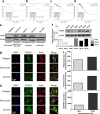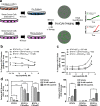A SNAI2-PEAK1-INHBA stromal axis drives progression and lapatinib resistance in HER2-positive breast cancer by supporting subpopulations of tumor cells positive for antiapoptotic and stress signaling markers
- PMID: 34239043
- PMCID: PMC8376636
- DOI: 10.1038/s41388-021-01906-2
A SNAI2-PEAK1-INHBA stromal axis drives progression and lapatinib resistance in HER2-positive breast cancer by supporting subpopulations of tumor cells positive for antiapoptotic and stress signaling markers
Abstract
Intercellular mechanisms by which the stromal microenvironment contributes to solid tumor progression and targeted therapy resistance remain poorly understood, presenting significant clinical hurdles. PEAK1 (Pseudopodium-Enriched Atypical Kinase One) is an actin cytoskeleton- and focal adhesion-associated pseudokinase that promotes cell state plasticity and cancer metastasis by mediating growth factor-integrin signaling crosstalk. Here, we determined that stromal PEAK1 expression predicts poor outcomes in HER2-positive breast cancers high in SNAI2 expression and enriched for MSC content. Specifically, we identified that the fibroblastic stroma in HER2-positive breast cancer patient tissue stains positive for both nuclear SNAI2 and cytoplasmic PEAK1. Furthermore, mesenchymal stem cells (MSCs) and cancer-associated fibroblasts (CAFs) express high PEAK1 protein levels and potentiate tumorigenesis, lapatinib resistance and metastasis of HER2-positive breast cancer cells in a PEAK1-dependent manner. Analysis of PEAK1-dependent secreted factors from MSCs revealed INHBA/activin-A as a necessary factor in the conditioned media of PEAK1-expressing MSCs that promotes lapatinib resistance. Single-cell CycIF analysis of MSC-breast cancer cell co-cultures identified enrichment of p-Akthigh/p-gH2AXlow, MCL1high/p-gH2AXlow and GRP78high/VIMhigh breast cancer cell subpopulations by the presence of PEAK1-expressing MSCs and lapatinib treatment. Bioinformatic analyses on a PEAK1-centric stroma-tumor cell gene set and follow-up immunostaining of co-cultures predict targeting antiapoptotic and stress pathways as a means to improve targeted therapy responses and patient outcomes in HER2-positive breast cancer and other stroma-rich malignancies. These data provide the first evidence that PEAK1 promotes tumorigenic phenotypes through a previously unrecognized SNAI2-PEAK1-INHBA stromal cell axis.
© 2021. The Author(s).
Conflict of interest statement
The authors declare no competing interests.
Figures








Similar articles
-
Stromal SNAI2 Is Required for ERBB2 Breast Cancer Progression.Cancer Res. 2020 Dec 1;80(23):5216-5230. doi: 10.1158/0008-5472.CAN-20-0278. Epub 2020 Oct 6. Cancer Res. 2020. PMID: 33023950 Free PMC article.
-
Targeting the EphB4 receptor tyrosine kinase sensitizes HER2-positive breast cancer cells to Lapatinib.Cancer Lett. 2020 Apr 10;475:53-64. doi: 10.1016/j.canlet.2020.01.032. Epub 2020 Jan 29. Cancer Lett. 2020. PMID: 32006616
-
Fibroblast-tumor cell signaling limits HER2 kinase therapy response via activation of MTOR and antiapoptotic pathways.Proc Natl Acad Sci U S A. 2020 Jul 14;117(28):16500-16508. doi: 10.1073/pnas.2000648117. Epub 2020 Jun 29. Proc Natl Acad Sci U S A. 2020. PMID: 32601199 Free PMC article.
-
De-escalation of treatment in HER2-positive breast cancer: Determinants of response and mechanisms of resistance.Breast. 2017 Aug;34 Suppl 1(Suppl 1):S19-S26. doi: 10.1016/j.breast.2017.06.022. Epub 2017 Jul 4. Breast. 2017. PMID: 28687441 Free PMC article. Review.
-
Snail1 as a key prognostic biomarker of cancer-associated fibroblasts in breast tumors.Biochim Biophys Acta Rev Cancer. 2025 Jul;1880(3):189316. doi: 10.1016/j.bbcan.2025.189316. Epub 2025 Apr 11. Biochim Biophys Acta Rev Cancer. 2025. PMID: 40222423 Review.
Cited by
-
SHED-Dependent Oncogenic Signaling of the PEAK3 Pseudo-Kinase.Cancers (Basel). 2021 Dec 17;13(24):6344. doi: 10.3390/cancers13246344. Cancers (Basel). 2021. PMID: 34944965 Free PMC article.
-
Rational Design of HER2-Targeted Combination Therapies to Reverse Drug Resistance in Fibroblast-Protected HER2+ Breast Cancer Cells.Cell Mol Bioeng. 2024 Oct 11;17(5):491-506. doi: 10.1007/s12195-024-00823-0. eCollection 2024 Oct. Cell Mol Bioeng. 2024. PMID: 39513002 Free PMC article.
-
Tumor-associated mesenchymal stem/stromal cells in tumor microenvironment and carcinogenesis.Exp Hematol Oncol. 2025 Jul 17;14(1):97. doi: 10.1186/s40164-025-00688-7. Exp Hematol Oncol. 2025. PMID: 40676710 Free PMC article. Review.
-
INHBA+ macrophages and Pro-inflammatory CAFs are associated with distinctive immunosuppressive tumor microenvironment in submucous Fibrosis-Derived oral squamous cell carcinoma.BMC Cancer. 2025 May 12;25(1):857. doi: 10.1186/s12885-025-14261-2. BMC Cancer. 2025. PMID: 40355814 Free PMC article.
-
Fate decisions of breast cancer stem cells in cancer progression.Front Oncol. 2022 Aug 15;12:968306. doi: 10.3389/fonc.2022.968306. eCollection 2022. Front Oncol. 2022. PMID: 36046046 Free PMC article. Review.
References
-
- Yuan S, Norgard RJ, Stanger BZ. Cellular plasticity in cancer. Cancer Discov. 2019;9:837–851. doi: 10.1158/2159-8290.CD-19-0015. - DOI - PMC - PubMed
-
- Marusyk A, Tabassum DP, Janiszewska M, Place AE, Trinh A, Rozhok AI, et al. Spatial proximity to fibroblasts impacts molecular features and therapeutic sensitivity of breast cancer cells influencing clinical outcomes. Cancer Res. 2016;76:6495–6506. doi: 10.1158/0008-5472.CAN-16-1457. - DOI - PMC - PubMed
Publication types
MeSH terms
Substances
Grants and funding
LinkOut - more resources
Full Text Sources
Medical
Research Materials
Miscellaneous

